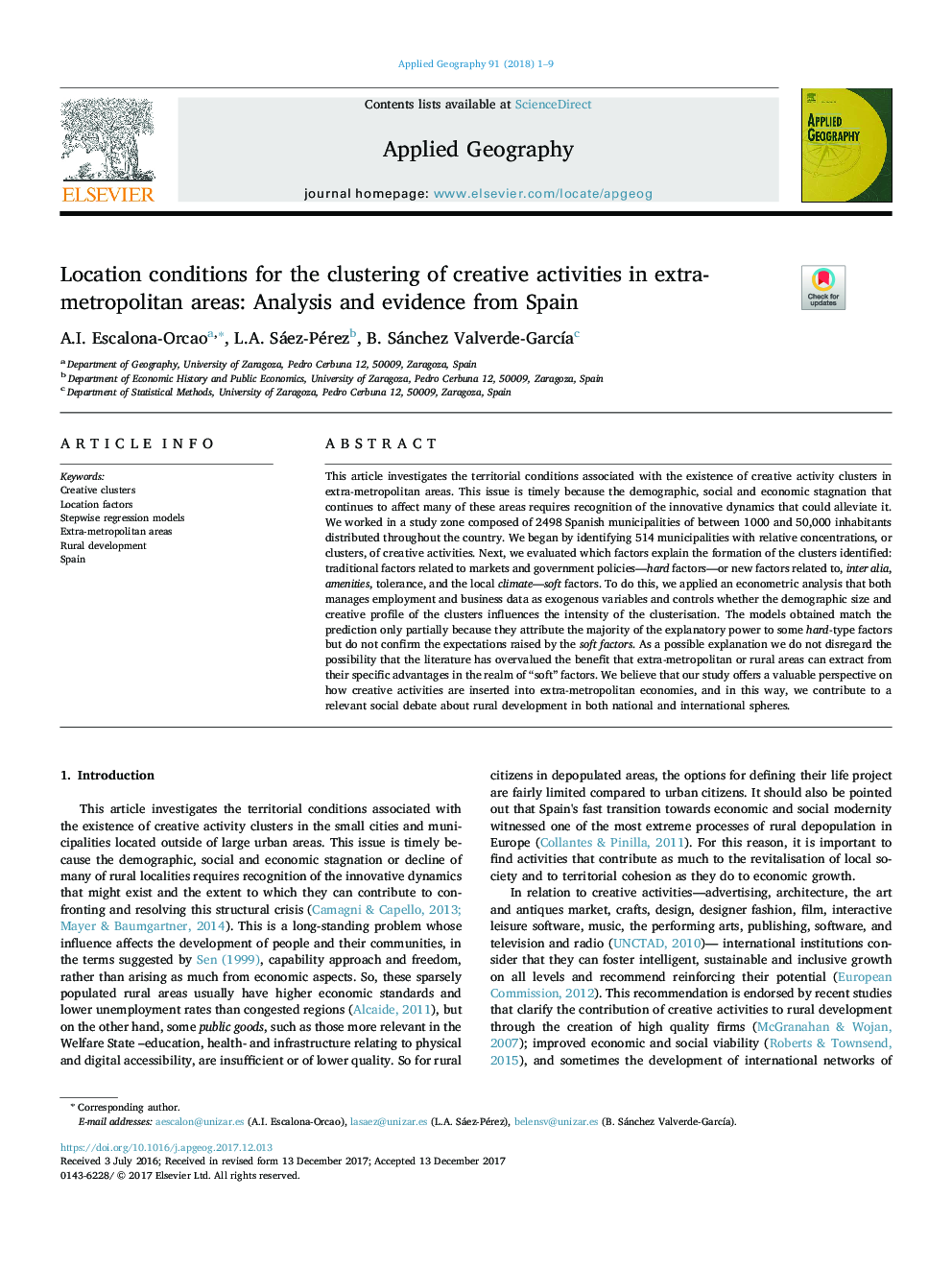| کد مقاله | کد نشریه | سال انتشار | مقاله انگلیسی | نسخه تمام متن |
|---|---|---|---|---|
| 6538325 | 1421026 | 2018 | 9 صفحه PDF | دانلود رایگان |
عنوان انگلیسی مقاله ISI
Location conditions for the clustering of creative activities in extra-metropolitan areas: Analysis and evidence from Spain
ترجمه فارسی عنوان
شرایط محل برای خوشه بندی فعالیت های خلاقانه در مناطق فوقانی شهری: تجزیه و تحلیل و شواهد از اسپانیا
دانلود مقاله + سفارش ترجمه
دانلود مقاله ISI انگلیسی
رایگان برای ایرانیان
کلمات کلیدی
خوشه های خلاق، فاکتور محل سکونت، مدل رگرسیون گام به گام، مناطق فوق العاده شهری، توسعه روستایی، اسپانیا،
ترجمه چکیده
این مقاله به بررسی شرایط ارضی مربوط به وجود خوشه های فعالیت خلاق در مناطق فوقانی شهری می پردازد. این موضوع به موقع است زیرا رکود جمعیتی، اجتماعی و اقتصادی که همچنان در بسیاری از این مناطق تاثیر می گذارد، نیازمند شناخت پویایی های نوآورانه ای است که می تواند آن را کاهش دهد. ما در یک منطقه تحصیلی متشکل از 2498 شهرداری اسپانیایی بین 1000 تا 50،000 ساکن در سراسر کشور کار می کردیم. ما با شناسایی 514 شهرداری با تمرکز نسبی یا خوشه ای از فعالیت های خلاقانه شروع کردیم. بعد، ما بررسی کردیم که عوامل تشریح شکل گیری خوشه های شناسایی شده: عوامل سنتی مربوط به بازار و سیاست های دولتی - عوامل سخت - یا عوامل جدید مربوط به، از جمله امکانات، تحمل، و عوامل محلی محیط زیست نرم. برای انجام این کار، ما یک تحلیل اقتصادسنجی را انجام دادیم که هر دو مدیریت داده های اشتغال و کسب و کار را به عنوان متغیرهای خارجی و کنترل می کند که آیا اندازه جمعیت و مشخصات خلاق خوشه ها بر شدت خوشه بندی تأثیر می گذارد. مدل های به دست آمده تنها پیش از این پیش بینی را مطابقت می دهند، زیرا اکثریت قدرت توضیحی را به برخی از عوامل سخت افزاری تقسیم می کنند اما انتظارات مطرح شده توسط عوامل نرم را تایید نمی کنند. به عنوان یک توضیح احتمالی، ما نادیده گرفتیم که ادبیات مزایایی را به وجود می آورد که مناطق خارج از شهر یا روستاها می توانند از مزایای خاص خود در قلمرو صفتا استخراج کنند؟ عوامل. ما بر این باوریم که مطالعه ما دیدگاه ارزشمندی را در مورد فعالیتهای خلاقانه در اقتصادهای فوقانی شهری ارائه می دهد و به این ترتیب ما در بحث های اجتماعی مربوط به توسعه روستایی در حوزه های ملی و بین المللی مشارکت می کنیم.
موضوعات مرتبط
علوم زیستی و بیوفناوری
علوم کشاورزی و بیولوژیک
جنگلداری
چکیده انگلیسی
This article investigates the territorial conditions associated with the existence of creative activity clusters in extra-metropolitan areas. This issue is timely because the demographic, social and economic stagnation that continues to affect many of these areas requires recognition of the innovative dynamics that could alleviate it. We worked in a study zone composed of 2498 Spanish municipalities of between 1000 and 50,000 inhabitants distributed throughout the country. We began by identifying 514 municipalities with relative concentrations, or clusters, of creative activities. Next, we evaluated which factors explain the formation of the clusters identified: traditional factors related to markets and government policies-hard factors-or new factors related to, inter alia, amenities, tolerance, and the local climate-soft factors. To do this, we applied an econometric analysis that both manages employment and business data as exogenous variables and controls whether the demographic size and creative profile of the clusters influences the intensity of the clusterisation. The models obtained match the prediction only partially because they attribute the majority of the explanatory power to some hard-type factors but do not confirm the expectations raised by the soft factors. As a possible explanation we do not disregard the possibility that the literature has overvalued the benefit that extra-metropolitan or rural areas can extract from their specific advantages in the realm of “soft” factors. We believe that our study offers a valuable perspective on how creative activities are inserted into extra-metropolitan economies, and in this way, we contribute to a relevant social debate about rural development in both national and international spheres.
ناشر
Database: Elsevier - ScienceDirect (ساینس دایرکت)
Journal: Applied Geography - Volume 91, February 2018, Pages 1-9
Journal: Applied Geography - Volume 91, February 2018, Pages 1-9
نویسندگان
A.I. Escalona-Orcao, L.A. Sáez-Pérez, B. Sánchez-Valverde GarcÃa,
